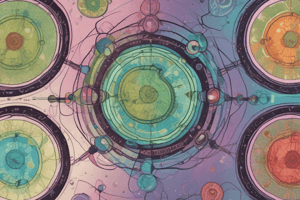Podcast
Questions and Answers
Match the following terms with their descriptions:
Match the following terms with their descriptions:
S phase = Part of the cell cycle where DNA is synthesized Synthesis phase = Another term for S phase in the cell cycle Sister chromatids = Identical sets of chromosomes joined together by centromeres Centromeres = Region where sister chromatids are joined together
Match the following statements with the correct stage of the cell cycle:
Match the following statements with the correct stage of the cell cycle:
DNA replication occurs = S phase Cells reproduce themselves = Cell cycle Mitosis and cytokinesis happen = Division stage Genetic material is doubled = Purpose of S phase
Match the following outcomes with their potential consequence if S phase did not occur correctly:
Match the following outcomes with their potential consequence if S phase did not occur correctly:
Daughter cells lack genetic code = Nonviable cells Cells unable to function independently = Insufficient genetic material Half of genetic code missing = Non-functional offspring cells Reduced chromosome sets in daughter cells = Cell viability compromised
Match the following processes with their importance in maintaining healthy organisms:
Match the following processes with their importance in maintaining healthy organisms:
Match the following terms with their function in DNA replication during S phase:
Match the following terms with their function in DNA replication during S phase:
Flashcards are hidden until you start studying
Study Notes
Cell Cycle Overview
The cell cycle is the series of events that lead to the duplication and division of cells. It consists of four main phases: G1, S, G2, and M, with the S phase being particularly significant in this context. The entire process can be divided into three distinct stages: interphase, mitosis, and cytokinesis. Understanding these different parts is essential for comprehending the complexities of the human body and maintaining its health.
Interphase
Interphase is the longest phase of the cell cycle, lasting from birth until the next cell division occurs. During this stage, the chromosomes are uncoiled and dispersed throughout the nucleus, forming structures known as chromatin fibers. In addition, the cell continues to grow and complete other necessary functions while preparing itself for replication.
Mitosis
Mitosis begins once the cell has completed meiosis and the genetic material has been precisely sorted into homologous pairs of chromosomes. This process involves several steps: prophase, prometaphase, metaphase, anaphase, and telophase. Each step ensures that the daughter cells receive an identical set of genetic information.
Cytokinesis
Cytokinesis follows immediately after mitosis and divides the cytoplasm between the two new daughter cells. This separation helps ensure that each new cell receives everything it needs to function independently. While the specific mechanics of cytokinesis vary among species, the fundamental goal remains the same across all life forms—to divide the parent cell's contents equally between the two new offspring cells.
S Phase: DNA Replication
The S phase, or Synthesis phase, is the part of the cell cycle during which the DNA within the cell is synthesized. This means that each strand of the double helix is copied, resulting in two identical sets of chromosomes (called sister chromatids) joined together by their centromeres. The purpose of this stage is to make sure that both cells created through mitosis have enough genetic material to function independently. If the S phase did not occur correctly, the daughter cells would lack half of their genetic code, rendering them nonviable.
In summary, the cell cycle is the process by which cells reproduce themselves and includes various stages such as growth, DNA replication (S phase), and division (mitosis and cytokinesis). These processes are crucial for maintaining healthy organisms because they allow cells to be replaced when damaged, dividing into specialized tissues, organs, and systems.
Studying That Suits You
Use AI to generate personalized quizzes and flashcards to suit your learning preferences.




